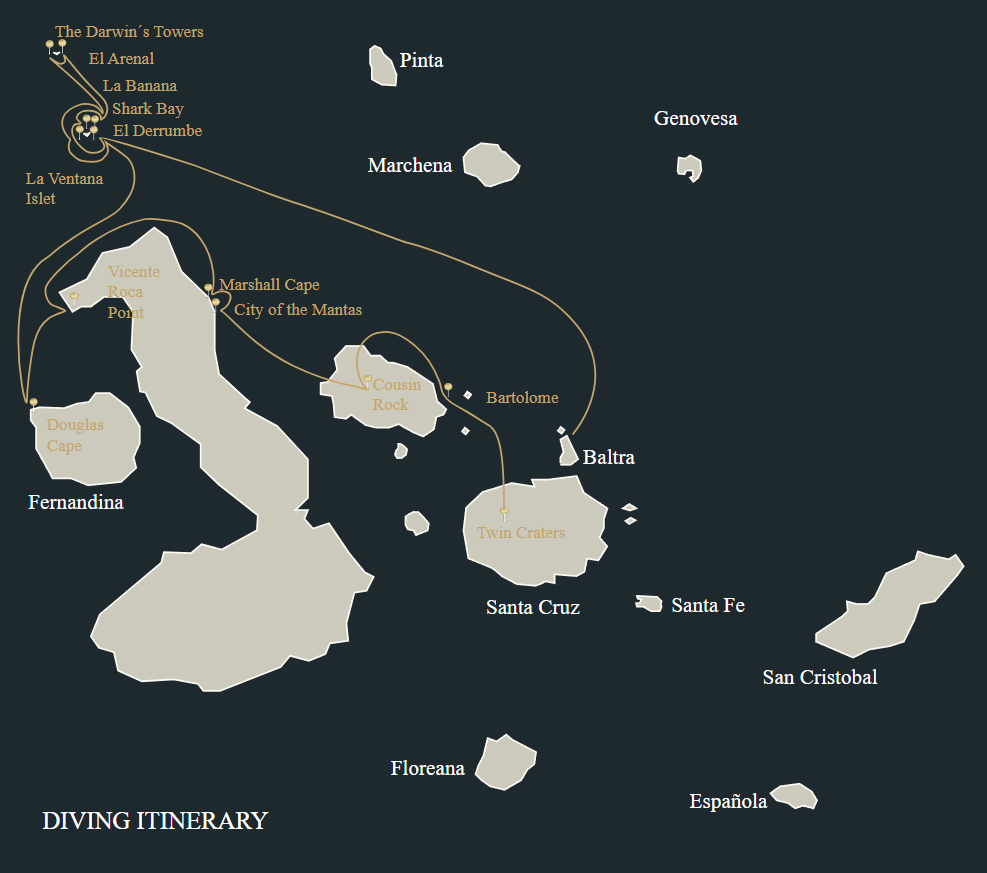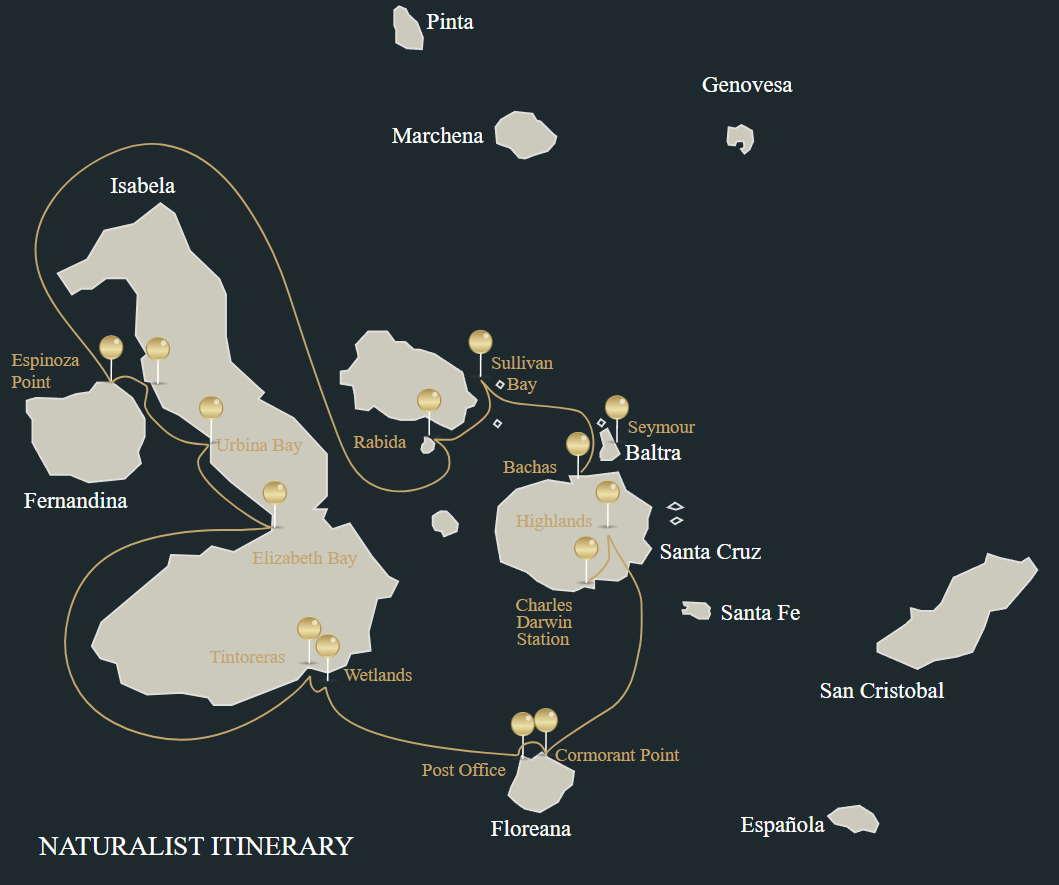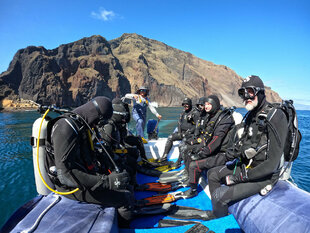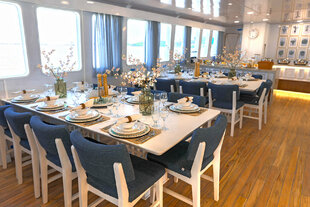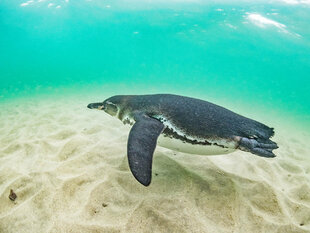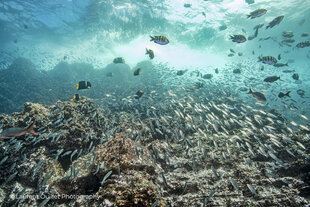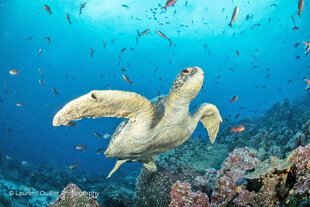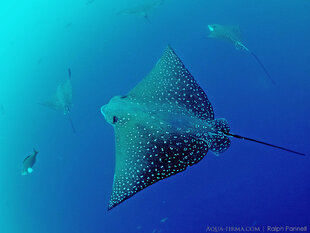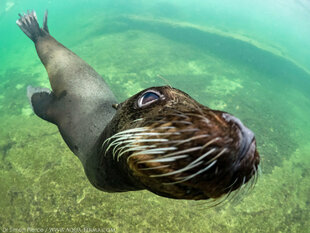Galaxy Diver II is a dive liveaboard boat rebuilt in 2023, giving it modern and efficient functionality. A diving itinerary is offered as well as a naturalist itinerary with no diving activities – both are 8 days and 7 nights in duration. Both itineraries give you the opportunity to take part in many different activities, such as snorkelling, kayaking, panga rides and hiking.
The ship can accommodate up to 16 guests in the 8 ensuite double cabins which are onboard, designed with endemic local-style decorations and with lowered beds for easier accessibility. Also in each cabin are closets for storage of clothes, air conditioning, reading lights and charging ports. Bathrooms in each of the cabins have a shower with hot and cold water, a hair dryer and a towel. Soap, shampoo and conditioner is also provided.
The dining room has wide windows for good views of the surroundings. National and international cuisine is served onboard either served as a menu or buffet. Dietary requirements can be met provided that they are informed of prior to booking. Purified water and hot drinks are available 24 hours a day.
Places to relax whilst enjoying your time between activities can also be spent in other locations on the boat, such as the lounge and sundeck. The indoor lounge on Galaxy Diver II is located on the main deck towards the stern of the ship. Here, there is a TV, DVD player and small library for night-time entertainment. The large windows let in plenty of natural light and give a large sea view. Neighbouring this is the outdoor bar, where you can enjoy a range of cocktails, national and international drinks, as well as local fruit juices. The boat’s sundeck is a great place to relax in the sun, with chaise longues, a hot tub and 360° views for wildlife and landscape observations.
Diving, Wildlife & Photography
The primary focus of the trips offered on this boat is diving with marine life in the Galapagos. You will be swimming in the waters of Wolf and Darwin Islands, known for their abundance of sharks like Hammerheads and White-Tips – even Whale Sharks in the right season. It is also common to see Turtles, schools of Tuna, Eagle Rays and Sealions.
There are plenty of opportunities for underwater photographers on these itineraries, not only for marine life already mentioned, but also of complex and unique underwater rock formations. There are great subjects for macro photographers, with opportunities for shots of Sea Horses, Barnacle Blennies and Coral Hawkfish among others.
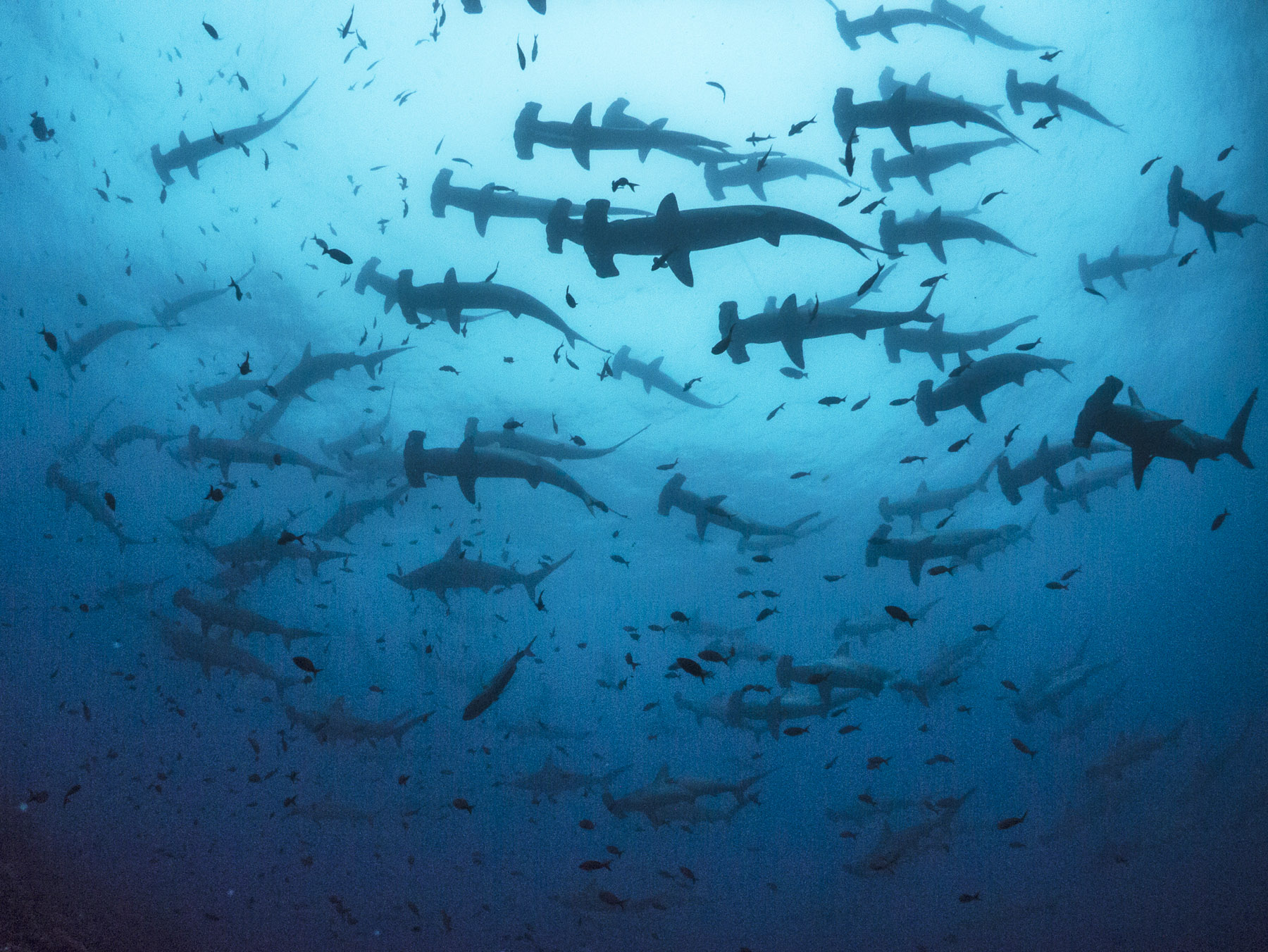
Although the diving in the Galapagos gives a brilliant experience of the archipelago, there are many opportunities to explore more of the islands above the water. This ship does include some activities above water but if you would like to explore more of the Galapagos Islands through land-based excursions, you could consider adding more time to your stay by choosing an add-on experience, such as the ship's naturalist itinerary or one from our Galapagos page.
Technical Specifications
| Life rafts | 2x 25-person |
| Safety | Smoke & fire alarms, automatic fire extinguishing system in engine room, lifejackets for guests & crew, fire extinguishers, 9mm lifebuoys & an emergency alarm system |
| Navigation | 406 MHz EPIRB & 9 GHz radar responder |
| Length | 29.5 m / 96.9 ft |
| Beam | 6.6 m / 21.7 ft |
| Cruising speed | 10 knots |
| Electricity | 110V & 220V AC 60Hz |
| Engines | Tenders 2x PUMAR (with 25 hp outboards) |
| Guest capacity | Maximum 16 (+ 2 dive guides on dive itinerary) |
| Water capacity | 9,800 L / 2,160 gallons |
| Fuel capacity | 15,100 L / 3,320 gallons |
| Diving equipment | 2x LW dive tank compressors for enriched air, Nitrox, aluminium diving tanks (10, 12 & 15 L) with DIN & international fittings |
Deck Plan
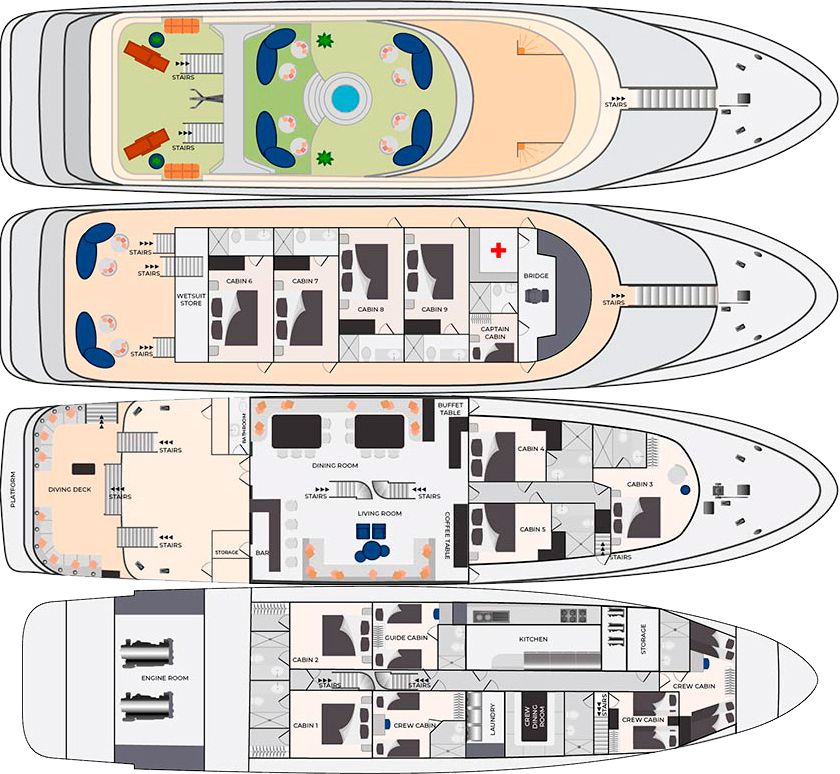
Itinerary
Day 1 (Wednesday) – Arrival & Checkout Dive
AM: Arrival, Baltra Island
Upon arrival Baltra, travellers pass through an airport inspection point to make sure that no foreign plants or animals are introduced to the islands, and to pay the park entrance fee of $200 (unless it has been prepaid). A guide will meet you, help you collect your luggage and escort you on a short bus ride to the harbour.
PM: Checkout Dive
Day 2 (Thursday) – Carrion Point & Navigation
AM: Punta Carrion, Santa Cruz Island
Punta Carrion, on the northeast coast of Santa Cruz Island, provides a great diving spot where you can hope to see Hammerhead Sharks and even Whale Sharks between June and December. Smaller marine fauna in this location includes White-Tip Reef Sharks, Stingrays, Sea Lions and a colourful array of tropical fish.
PM: Navigation to Wolf Island
In the afternoon, you will enjoy an extended time on Galaxy Diver II as you begin the 14-hour journey to Wolf Island, the next location on your itinerary. During this time, you can experience the yacht’s social areas, like the lounge, bar and sun deck where you can keep an eye out for wildlife sightings and enjoy being surrounded by the archipelago’s landscapes.
Day 3 (Friday) – Shark Bay, North Islet, Window Islet & the Landslide
AM: Shark Bay, Wolf Island
Shark Bay is on the east side of Wolf Island and is shallower than most other sites around it but one of the most memorable due to high Whale Shark traffic which gave the site its name. There are also local cleaning stations here where you can see visiting Hawksbill & Pacific Green Turtles.
PM: La Banana, La Ventana Islet & El Derrumbe, Wolf Island
La Banana, also known as North Islet, has a sheer wall whose shape resembles that of a banana and is dotted with caverns, tunnels and other interesting rock formations. This dive site normally has great visibility and equally good marine life, with highlights including Galapagos Sharks, Hammerheads, Manta Rays and Green Turtles.
At La Ventana Islet (Window Islet in English), there is diverse marine life. One of the biggest highlights here is the Red-Lipped Batfish, which walk around on the sea floor. Hiding in and swimming around the complex rock formations are many other sea creatures, such as Moray Eels, Barracuda, Dolphins, White-Tip Sharks and Hammerheads. Whale Sharks can even be seen here between May and November.
The Landslide is one of the best dive sites of Wolf Island, with hundreds of Hammerhead Sharks circling around or heading against the current in some seasons. This drift diving site follows a boulder slope underneath the partly collapsed east cliffs of the islet leading to a hangout between the boulders where you can see Requiem Sharks, pelagic schools. In hotter seasons, Pacific Green Turtles, Spotted Eagle Rays and, sometimes, Mobula Devil Rays and Giant Oceanic Mantas can be seen here too.
Day 4 (Saturday) – El Arenal & Darwin’s Arch
AM: El Arenal, Darwin Island
This dive site brings you close to the cleaning stations of Darwin Island, where Sharks, Turtles and Jacks regularly visit to be freed from parasites by the resident Barber Fish and King Angelfish. The busiest area here is the sandy slope in front of El Arenal portal. When the surge isn’t too strong, being dropped off here allows you to come face-to-face with Scalloped Hammerheads and resting Pacific Green and Hawksbill Turtles. As you swim further out, you can see the sloping shelves of rubble dropping into a deep gully, with the upper edges offering hideouts for Hammerheads. Other highlights here, depending on the season, include Whale Sharks, Bottlenose Dolphins, Mobula and Devil Rays and Giant Oceanic Mantas.
PM: Arco de Darwin, Darwin Island
Darwin’s Arch, now a pillar formation since the arch collapsed in 2021, is one of the Galapagos’ most iconic locations. The shallow reef platforms around the landmark make this a great diving spot for seeing schools of Scalloped Hammerheads. Whale Sharks can also be seen here, mostly between June and November, with females making a stop-off during their solitary migrations.
Day 5 (Sunday) – El Arenal, the Landslide & Shark Bay
You will revisit these 3 iconic dive sites – El Arenal in the morning and El Derrumbe and Shark Bay in the afternoon.
Day 6 (Monday) – Cape Marshall
AM + PM: Cabo Marshall, Isabela Island
Cape Marshall in on the north-east side of Isabela and is home to a few great diving spots. In these dive locations, it is easiest to drift dive across a black coral-coated vertical wall descending to the seabed where Hammerhead, White-Tipped & Galapagos sharks can be spotted. Even Whale Sharks have been seen here. Other marine life includes large schools of Black-Striped Salema and Barracuda.
Day 7 (Tuesday) – Cousins Rock & Highlands
AM: Cousins Rock, Santiago Island
Cousins Rock dive site is characterised by its sloping rock formation which is home to many reef-dwelling marine animals such as Seahorses, Octopus, Sharks, Sea Lions and Green Turtles.
PM: Highlands, Santa Cruz Island
The road to the highlands leaves from Bellavista, a small village located a 15-minute drive from Santa Cruz’ main town of Puerto Ayora. The road passes through the Galapagos’ most productive agricultural zone, up to the National Park boundary. We find Miconia vegetation at this altitude, changing to the Fern and Sedge zone as we ascend further. With clear weather, we can enjoy beautiful scenes of rolling hills and extinct volcanic cones covered with grass and lush greenery all year round. In the Highlands is El Chato Reserve, where Giant Galapagos Tortoises can be observed in the wild – the iconic species which gave the Galapagos Islands their name. Other species to see at this reserve include Short-Eared Owls, Yellow Warblers & Finches. More elusive species which can be difficult to spot here are Galapagos Rails & Paint-Billed Crakes.
Day 8 (Wednesday) – Departure
AM: Departure, Baltra Island
Your guide & some crew members will go with you to Baltra where you will board the airport shuttle. Your guide will remain with you through the check-in counters & departure hall.
Day 1 (Wednesday) – Arrival & Bachas Beach
AM: Arrival, Baltra Island
Upon arrival Baltra, travellers pass through an airport inspection point to make sure that no foreign plants or animals are introduced to the islands, and to pay the park entrance fee of $200 (unless it has been prepaid). A guide will meet you, help you collect your luggage and escort you on a short bus ride to the harbour.
PM: Playa las Bachas, Santa Cruz Island
These two small beaches are found to the west of Turtle Cove. Their sand is made of decomposed coral, which makes it white and soft, and a favourite nesting site for sea turtles. Behind one of the beaches there is a small brackish water lagoon, where it is occasionally possible to observe flamingos and other coastal birds, such as black-necked stilts and whimbrels.
The other beach is longer, but it has two old barges that were abandoned during World War II, when USA used Baltra Island as a strategic point from which to protect the Panama Channel. The rocky shoreline can be a great place to photography Sally Lightfoot Crabs.
Day 2 (Thursday) – Sullivan Bay & Rábida
AM: Sullivan Bay, Santiago Island
Setting foot at the lava stream covering Sullivan Bay is like landing on the moon. The desolate, stretched out lava fields seem mostly lifeless, but there is plenty to see on this highly popular site, with lots to photograph. Pacific green turtles seasonally bury eggs in the tiny white sand beach, where you might also encounter crabs, a stray blue heron or an American oystercatcher. On the lava flows sparse pioneer vegetation such as lava cacti and carpetweed are able to grow. You might also encounter a lava lizard, locusts or a small species of snake called the Galapagos racer.
PM: Rábida Island
Rábida Island is unique because of the red colour of the rocks and sand. The volcanic material on this island is very porous and external factors such as rain, saltwater and sea breeze have acted as an oxidising agent. A short walk along a trail leads us to a coastal lagoon behind the beach where we can see land birds including finches, doves, yellow warblers and mockingbirds; seabirds such as pelicans, masked and blue-footed boobies; and of non-feathered species you can hope to see marine iguanas and sealions. Our team will take you to a small brackish lagoon where you can anticipate a colony of flamingos.
Day 3 (Friday) – Espinosa Point & Tagus Cove
AM: Punta Espinoza, Fernandina Island
Fernandina is the third largest island in the archipelago and has a single visitor site: Punta Espinoza, located at the northeastern tip of the island. Here, marine iguanas conglomerate in larger groups than on any other island. They bask around in the sand, swim near the shore and sometimes block the way at the landing dock. Among the unique species found here, we can find the flightless cormorant.
PM: Tagus Cove, Isabela Island
A tour along the cliffs will give visitors a good chance to see the Galapagos penguin, the flightless cormorant and other seabirds. From the landing dock, it is about a 30-minute hike along the trail up to the top of the cliff from where you can view Darwin Lake, an uplifted lake saltier than the sea. You can also see several volcanoes from this location. Look carefully at the graffiti on the surrounding cliffs of the cove, done by pirates, whalers and buccaneers in past centuries!
Day 4 (Saturday) – Urbina Bay & Elizabeth Bay
AM: Urbina Bay, Isabela Island
Urbina Bay is on the west coast of Isabela and has a recently uplifted seabed which has forced corals up above the water’s surface, providing a unique snorkelling experience. There are 2 treks at this bay which offer chances of seeing Galapagos Tortoises & large Land Iguanas amongst other wildlife including Flycatchers, Finches & Mockingbirds.
PM: Elizabeth Bay, Isabela Island
This is a marine visitor site, so the excursion has no landing point. Your panga ride starts with a visit to the Marielas islets: home to the largest and most important penguin colony in the Galapagos Islands. The excursion continues into a cove, surrounded by red mangroves, where you can admire their red roots and green leaves. Here, you might be able to observe sea turtles, flightless cormorants, spotted eagle rays, golden cownose rays, brown pelicans and sealions. You might also see Galapagos hawks soaring overhead with schools of pompano and dorado fish swimming down below.
Day 5 (Sunday) – Tintoreras & Wetlands
AM: Las Tintoreras Islets, Isabela Island
Las Tintoreras are small islands which lie just offshore from Puerto Villamil – the small, but main town on Isabela. A visit here can be very rewarding. If Galapagos Penguins are around then they might well be the first life you see as you approach by small boat – standing or lying on bare lava rocks, close to the spreading roots of mangroves. Blue-footed boobies are often seen on the same rocks and amongst bright green mangrove foliage.
As you step ashore, take care as there may be hundreds of small young marine iguanas. As you proceed past impossibly sharp and contorted lava, you will come to lava tunnels where white-tip reef sharks (tintoreras in Spanish) rest in shallow water. Sally Lightfoot crabs can be observed on the cliffs leading down to the water.
Further along, you will come to a lagoon and a beach occupied by bull sealion and his harem. In the lagoon you might see marine life such as a Spotted Eagle Ray in the shallows.
PM: Wetlands, Isabela Island
Leading from the Centre to the western beaches of Puerto Villamil is a woodland trail and boardwalk through a series of saline lagoons. This can be a good place to see graceful American flamingos, filtering the saline water for shrimp and algae. They are joined by a handful of species of aquatic and shore birds; as well as marine iguanas as you approach the trail where it meets the sea.
Day 6 (Monday) – Post Office Bay & Cormorant Point
AM: Post Office Bay, Floreana Island
Post Office Bay is primarily of cultural significance. In times before there was a reliable postal service, a barrel onshore was a point where British 16th century whalers and poachers could post a letter. You are encouraged to write and address one or two post cards; whilst at the same time picking out any which are addressed close to your home, which you are happy to hand deliver when you return.
Shallow waters offshore are lovely to swim in. If you doon a mask and snorkel, you might see Pacific green turtles which often graze here.
PM: Punta Cormorant, Floreana Island
The peninsula of Punta Cormorant (Cormorant Point) marks the extreme northern cape of Floreana – an island formed from smaller volcanic cones, covered now by tropical dry forest (palo santo). At the landing beach, you are likely to be welcomed by a small colony of Galapagos sealions. The green sand on this beach contains a high percentage of glassy olivine crystals which have been blown out by the surrounding tuff cones.
The ‘flour sand’ beach on the southern side of the peninsula is made up of white coral ground into sand by Parrotfish. It feels very smooth on the feet. You may be able to spot stingrays who use the sandy bottom to bury themselves. During the first months of the year, Pacific green turtles come ashore to dig a nest in which to bury their eggs.
Day 7 (Tuesday) – Highlands & Darwin Station
AM: Highlands, Santa Cruz Island
The road to the highlands leaves from Bellavista, a small village located a 15-minute drive from Santa Cruz’ main town of Puerto Ayora. The road passes through the Galapagos’ most productive agricultural zone, up to the National Park boundary. We find Miconia vegetation at this altitude, changing to the Fern and Sedge zone as we ascend further. With clear weather, we can enjoy beautiful scenes of rolling hills and extinct volcanic cones covered with grass and lush greenery all year round. In the Highlands is El Chato Reserve, where Giant Galapagos Tortoises can be observed in the wild – the iconic species which gave the Galapagos Islands their name. Other species to see at this reserve include Short-Eared Owls, Yellow Warblers & Finches. More elusive species which can be difficult to spot here are Galapagos Rails & Paint-Billed Crakes.
PM: Charles Darwin Research Station, Santa Cruz Island
Although the great majority of Galapagos visitors come to the Charles Darwin Research Station to observe and appreciate natural wonders, it is also interesting to learn how the protection and conservation of the islands are carried out. The main attractions are the National Park information centre, the Van Staelen Exhibition Hall, the Breeding and Rearing Centre for young tortoises, and adult Galapagos tortoises in captivity.
Day 8 (Wednesday) – North Seymour & Departure
AM: North Seymour Island
This islet is one of most visited sites in the Galapagos and it is teeming with birdlife. An easy circular path takes you through the archipelago’s most extensive colonies of blue-footed boobies and frigate birds. At the beginning of the breeding season, adult frigatebird-males blow up their vivid red pouches (gulas) to impressive football-sized balloons. This is one of the few spots where you can compare the magnificent and the great frigatebird breeding next to each other.
You are likely to come across several land iguanas on North Seymour and the coast can be a good place to spot Galapagos sealions.
PM: Departure, Baltra Island
Your guide & some crew members will go with you to Baltra where you will board the airport shuttle. Your guide will remain with you through the check-in counters & departure hall.
Dates
Diving Itinerary (8 days / 7 nights)
Children must be 6 or older to attend the naturalist itinerary. To attend diving itinerary, divers must have 50 or more logged dives and 15 years old or older (under 18s must be accompanied by a certified adult whilst diving)
Included
Airport assistance
Transfers in Galapagos with the group
Accommodation in double cabin
All meals onboard
Certified diving & naturalist bilingual guides
All visits & excursions according to the itinerary
Kayaks & paddleboards for naturalist departures
Snorkelling gear on naturalist itinerary
Purified water, coffee & tea
Compressed air, tanks, weights & weight belts on diving itinerary
Excluded
Flight to/from Galapagos
Galapagos National Park entrance fee ($200)
Transit Card ($20)
Alcoholic drinks
Tips & gratuities
Local taxes
Travel, health & dive insurance
Services not specified
Dive gear not mentioned
Single Supplement
To book a cabin for single occupancy, a 50% supplement will be applied.

